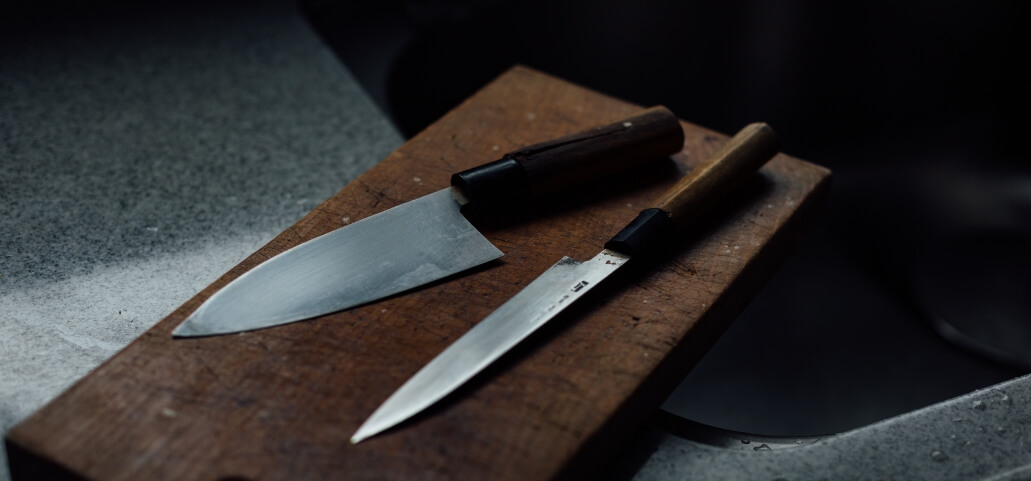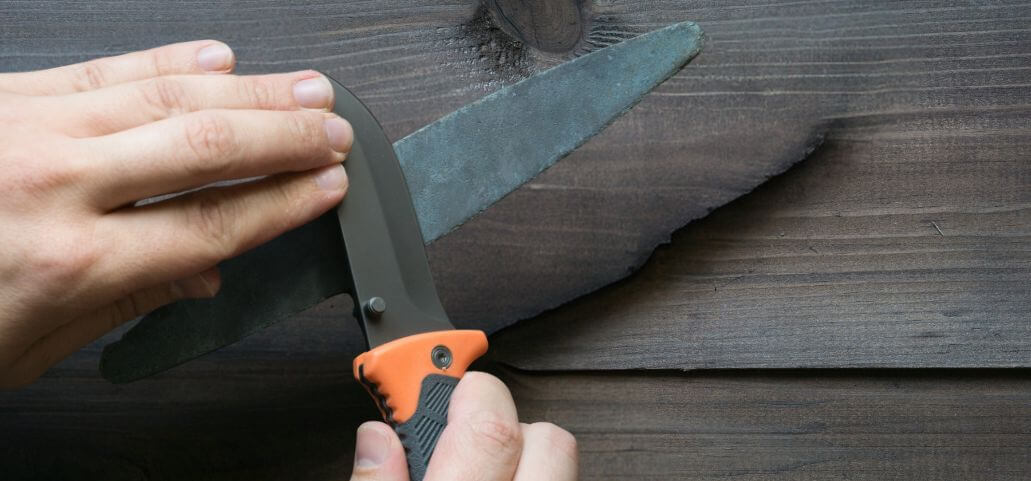Knowing how to sharpen kitchen knives is an essential skill for every home cook, ensuring safe and efficient food preparation. If you’ve ever struggled with dull blades, learning how to sharpen kitchen knives will transform your cooking experience. This guide will walk you through the steps to keep your knives razor-sharp, enhancing your culinary prowess, and making meal prep a breeze. Discover the best techniques and tools to maintain a perfect edge on your kitchen knives. So let’s dive in and explore how to sharpen kitchen knives.
Understanding Kitchen Knives
It’s important to know the many kinds of kitchen knives and their purposes before beginning the sharpening process.
Types of Kitchen Knives:
- Chef’s Knife: The kitchen workhorse, perfect for dicing, slicing, and chopping.
- Paring Knife: ideal for complex jobs like pruning and peeling.
- Bread Knife: It is perfect for slicing through crusty bread without smashing it because of its serrated edge.
- Santoku Knife: A versatile Japanese knife suitable for slicing, dicing, and mincing.
- Utility Knife: A more versatile and smaller knife that lies in the middle of a paring and chef’s knife.
Anatomy of a Kitchen Knife:
Understanding the anatomy of a kitchen knife can help you sharpen it correctly:
- Blade: The knife’s cutting edge.
- Edge: The blade’s keen edge.
- Spine: The blade’s upper, non-cutting edge.
- Handle: The part you hold, usually ergonomically designed for comfort.
Tools Needed for Sharpening Kitchen Knives
To sharpen your kitchen knives effectively, you’ll need the right tools. Here’s a list of essential and optional sharpening tools:
Essential Tools:
- Sharpening Stone (Whetstone): A versatile tool for manual sharpening.
- Honing Rod (Steel): Used to realign the edge of the knife.
- Electric Knife Sharpener: For easy and rapid honing.
- Knife Sharpening Guide: Aids in keeping the sharpening angle at the proper level.
Optional Tools:
- Leather Strop: For polishing the edge to a fine finish.
- Diamond-Coated Sharpening Rod: Offers aggressive sharpening for very dull knives.
Preparing to Sharpen Your Kitchen Knives
Before sharpening your knives, it’s important to prepare them properly:
- Clean Your Knives: Wash any leftover food particles or trash with soap and water.
- Dry Thoroughly: Ensure the blades are completely dry before starting the sharpening process.
- Assess Blade Condition: Check for chips, cracks, or nicks that may require professional repair.
- Wear Protective Gear: To prevent accidents, wear a cut-resistant glove on the hand holding the knife.
Step-by-Step Guide to Sharpening Kitchen Knives

There are several methods for sharpening kitchen knives, and each has its advantages and limitations. Let’s explore the two most common techniques:
Methods 1. Using a Sharpening Stone (Whetstone)
Sharpening stones, or whetstones, are multipurpose instruments for hand-held knife sharpening that extend the life and sharpness of your blades. The following is a detailed guide on how to use a whetstone:
- Step 1: Place the whetstone on a stable surface, such as a countertop or a non-slip mat, to ensure it doesn’t move while you work.
- Step 2: Using your dominant hand, hold the knife, and use your non-dominant hand to stabilize the whetstone.
- Step 3: Maintain a 15 to 20 degree angle between the knife and the stone. In order to achieve a sharp edge, try to maintain this angle throughout the process.
- Step 4: Using light to moderate pressure, sweep the blade back and forth across the stone in a smooth, controlled motion. Make sure the entire blade—from the heel to the tip—makes contact with the stone.
- Step 5: After you’ve turned the knife over, repeat the procedure on the opposite side of the blade. Consistency is key, so try to match the number of strokes and pressure applied on each side.
- Step 6: Continue sharpening until you achieve a fine edge on both sides of the blade. You can test the sharpness by gently running your thumb across (not along) the edge or using a piece of paper to see if it cuts cleanly.
- Step 7: Rinse off any metal shavings from the stone and knife, and dry both thoroughly before storing. Proper care of your whetstone, like drying it completely, will ensure it lasts longer and remains effective for future use.
Methods 2. Electric Knife Sharpening
Electric knife sharpeners offer a quick and convenient way to sharpen kitchen knives, ensuring they remain effective and safe for cutting. Here is a thorough how-to manual for one:
- Step 1: Begin by plugging in the electric sharpener and switching it on. Make sure you have a stable and clean surface to work on.
- Step 2: Hold the knife with your dominant hand and carefully insert the blade into the designated slot for sharpening. Most electric sharpeners have different slots for different levels of sharpening or types of blades.
- Step 3: Gently pull the knife towards you, allowing the electric sharpener to do the work. Apply consistent, light pressure to ensure an even sharpening process.
- Step 4: Until the blade is as sharp as you like, keep going through this process on both sides. Depending on the sharpener, you may need to run the knife through the coarse slot first and then through the fine slot for a polished edge.
- Step 5: Once you’re satisfied with the sharpness, switch off and unplug the sharpener before carefully removing your knife. Wipe the blade clean to remove any metal shavings and test the sharpness by slicing through a piece of paper or a tomato, ensuring it cuts smoothly.
Maintaining sharp kitchen knives not only makes cooking more efficient but also reduces the risk of accidents caused by dull blades.
Methods 3 . Using an Honing Rod (Steel)
A steel, sometimes referred to as an honing rod, is a vital instrument for realigning the edges of your knives and preserving their sharpness. Maintaining your knives can help them last a lot longer. Here’s how to make good use of one:
- Step 1: With the tip of the honing rod resting on a stable, non-slip surface, hold it vertically. Make sure the rod is steady before moving forward.
- Step 2: With your dominant hand, place the blade of your knife at a 15-20 degree angle against the rod near the handle. This angle is crucial for proper honing.
- Step 3: Pull the blade down and across the rod in a smooth, controlled motion, maintaining light pressure. Covering the entire blade—from heel to tip—is necessary.
- Step 4: To ensure consistent honing, repeat this motion on the opposite side of the blade. Continue alternating sides until the blade feels smooth and sharp to the touch, usually requiring 5-10 strokes per side.
- Step 5: After honing, rinse off any metal shavings from the rod to keep it clean and ready for the next use. After completely drying the rod, store it in a secure location.
You can maintain your knives’ best possible condition and make sure they meet all of your culinary needs by according to these guidelines.
Honing and Stropping Your Kitchen Knives
It’s critical to constantly sharpen and strop your knives in order to extend their useful life. Here’s what you need to know:
Honing:
- Regular honing keeps the blade aligned and sharp.
- Quick touch-ups can be accomplished with an electric knife sharpener or a steel honing rod.
Stropping:
- Stropping is the process of polishing the edge of a knife with a leather strop.
- This helps maintain a razor-sharp edge and removes any microscopic burrs left after sharpening.
Maintaining the Sharpness of Kitchen Knives

Sharpening your kitchen knives is only half the battle, as maintaining their sharpness is just as important. To maintain the sharpness of your kitchen knives, consider the following additional advice:
- Cutting on tough materials like granite or glass will quickly dull the blade, so avoid doing so.
- To keep your knives from rusting, clean and dry them after every use.
- Realign and polish the edge frequently using a leather strop or honing rod.
- To keep your blades safe from harm, keep them in a knife block or sheath.
- Consider investing in high-quality kitchen knives, as they tend to hold their sharpness better than cheaper ones.
By following these tips and techniques, you’ll be able to maintain your kitchen knives’ sharpness for longer periods, making your food prep easier and more efficient.
Common Mistakes to Avoid
To guarantee the finest results when sharpening your kitchen knives, avoid these frequent mistakes:
- Using too much pressure while sharpening can damage the blade.
- An uneven edge can be produced by sharpening at the incorrect angle.
- Neglecting to clean and dry your knives properly before sharpening can lead to rust buildup on the blade.
You can keep your knives in good condition and consistently attain a sharp edge by being aware of these common errors.
How to Sharpen Kitchen Knives with an Electric Sharpener
Sharpening your kitchen knives is easy and efficient with an electric knife sharpener. This is a detailed tutorial on using one:
- Step 1: Plug in the electric sharpener and turn it on.
- Step 2: Hold the knife with your dominant hand and insert the blade into the designated slot for sharpening.
- Step 3: Gently pull the knife towards you, letting the electric sharpener do the work.
- Step 4: Continue doing this on both sides until the appropriate degree of sharpness is reached.
- Step 5: Switch off and unplug the sharpener before removing your knife.
- Step 6: Rinse off any metal shavings and dry the blade before use.
Advantages and Limitations:
- Advantages: Electric sharpeners are easy to use, quick, and demand little effort.
- Limitations: They may offer less control and precision compared to manual sharpening methods.
Conclusion
In conclusion, knowing how to sharpen kitchen knives is a game-changer for any home cook. With the right techniques and tools, you can maintain your knives’ sharpness and efficiency, ensuring safer and more enjoyable cooking experiences. Keeping your kitchen knives sharp is a time-saver that also enhances the flavor of your cuisine. Embrace this essential skill and keep your culinary tools in top shape.
Frequently Asked Questions
Q1: How to sharpen kitchen knives without a sharpener?
Answer: You can use alternative tools such as a whetstone or sandpaper to sharpen your kitchen knives. However, these methods require more skill and may not achieve the same level of sharpness as using a dedicated knife sharpener.
Q2. Can I use a sharpening stone on serrated knives?
Answer: Serrated knives require special care. While you can use a sharpening stone for minor touch-ups, it’s best to use a serrated knife sharpener or consult a professional for proper maintenance.
Q3. What's the best angle for sharpening kitchen knives?
Answer: The majority of kitchen knives are sharpened at a 15 to 20 degree angle. For the blade to sharpen effectively and last a long time, this angle must be maintained.
Q4. Is stropping necessary for kitchen knives?
Answer: Stropping isn’t necessary but highly recommended. It polishes the edge, removes burrs, and provides a smoother, sharper finish, enhancing overall performance.
Q5. Can I sharpen my knives with a honing rod alone?
Answer: The knife is realigned with an honing rod to keep its edge sharp. It doesn’t sharpen the blade. Regular honing can extend the time between sharpening sessions but won’t replace sharpening entirely.
Disclaimer: This guide’s contents are solely intended for educational purposes. Sharpening tools should always be used carefully and in accordance with manufacturer recommendations. To prevent harm or damage, seek professional advice before sharpening your knives if you’re not sure how to do it.
Personal Experience: As a passionate home chef, I’ve experienced firsthand the difference a sharp knife can make in the kitchen. A few years ago, I invested in a high-quality sharpening stone and honing rod. Since then, maintaining my knives has become a rewarding ritual. The ability to achieve a razor-sharp edge has not only improved my cooking efficiency but also made meal prep more enjoyable. Trust me, once you experience the precision and ease of a properly sharpened knife, you’ll never go back to using dull blades.
Why Trust Our Content?
Our content is meticulously researched and crafted by culinary enthusiasts with a deep understanding of kitchen tools and techniques. We consult industry experts, review the latest advancements in knife sharpening technology, and test various methods to ensure we provide accurate and valuable information. Our goal is to empower home chefs and cooking enthusiasts with the knowledge they need to elevate their culinary skills.

